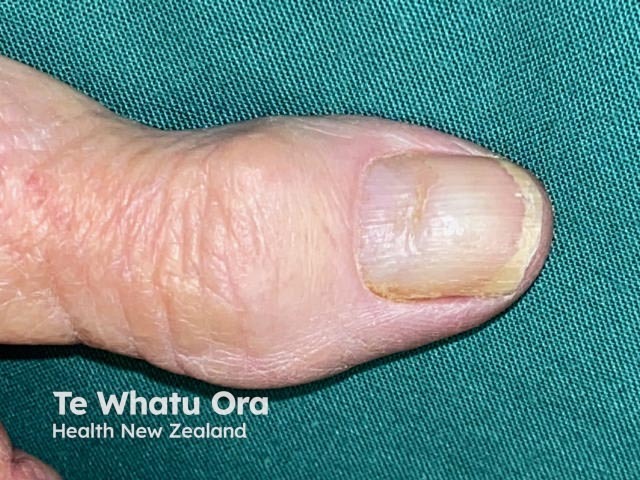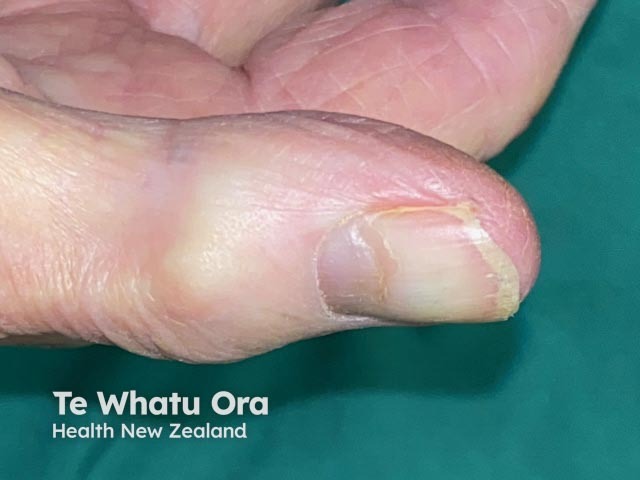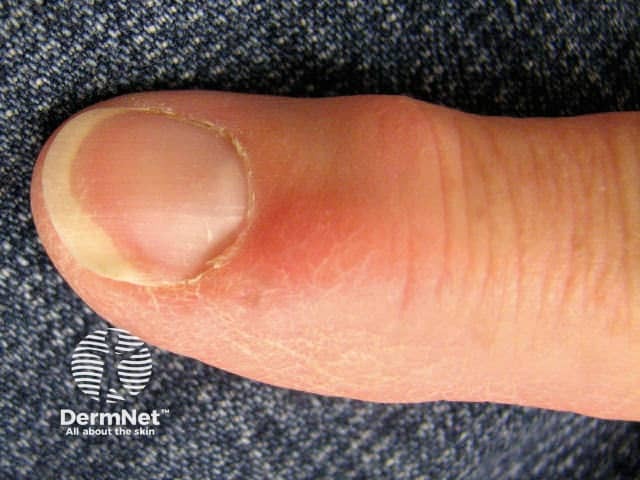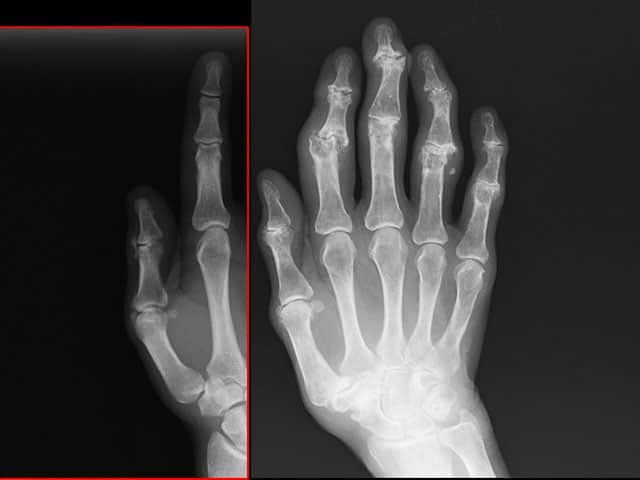Main menu
Common skin conditions

NEWS
Join DermNet PRO
Read more
Quick links
Heberden and Bouchard nodes — extra information
Heberden and Bouchard nodes
Author: Adjunct Assoc. Prof. Amanda Oakley, Dermatologist, Hamilton, New Zealand, March 2020.
Introduction Demographics Causes Clinical features Diagnosis Differential diagnoses Treatment
What are Heberden and Bouchard nodes?
A Heberden node describes a bony swelling of the distal interphalangeal finger joint. It is a sign of osteoarthritis, a degenerative joint disease.
A Bouchard node is a similar swelling affecting the proximal interphalangeal finger joint [1].

Heberden node

Heberden node
Who gets Heberden and Bouchard nodes?
Heberden and Bouchard nodes are equally common in males and females of all races.
- They are common in older individuals. However, more than half of the patients with Heberden nodes and osteoarthritis are diagnosed before the age of 65 years [2].
- Bouchard nodes are less common than Heberden nodes and are associated with more severe arthritis.
- The presence of the nodes is strongly familial [1].
- More than 60% of patients with osteoarthritis of the knees have Heberden nodes [3].
What causes Heberden and Bouchard nodes?
A Heberden or Bouchard node is due to an exostosis — a bony enlargement — and a sign of osteoarthritis. The cause of osteoarthritis is not fully understood. There is a genetic predisposition to the development of nodes [1].
Osteoarthritis is considered a sign of 'wear and tear' in a joint. The earliest structural abnormalities in osteoarthritis are evident in the ligaments supporting the joints [4]. The cartilage of the joints breaks down, osteophytes (bone spurs) develop, and the ends of the bones rub against each other.
Inflammation in the nodes is due to friction-induced capsular rupture and synovial leakage [1].
What are the clinical features of Heberden and Bouchard nodes?
A Heberden node is a bony swelling of a distal interphalangeal joint and a Bouchard node is a bony swelling of the proximal interphalangeal joint.
- Bony swelling can affect either the lateral or midline aspects of the joint or both [1].
- Multiple nodes can be present on one digit [2].
- The nodes can affect one or many digits.
- Nodes most often affect the middle finger or thumb of both hands.
- They may grow slowly or rapidly.
- The nodes may become inflamed and painful but are often painless and unnoticed.
- A Heberden node may be associated with a digital myxoid pseudocyst.
As well as affecting fingers, osteoarthritis causes discomfort, pain, and stiffness in other joints of the hands, knees, hips, and spine.

Heberden node and myxoid pseudocyst
How are Heberden and Bouchard nodes diagnosed?
The diagnosis of Heberden or Bouchard node is usually made clinically due to their characteristic appearance. Imaging may be performed on the affected digit.
- Ultrasound scanning reveals osteophytes, synovitis, and bony erosions of osteoarthritis [5].
- A plain X-ray of the affected joint may show interphalangeal osteophytes, although correlation is poor with clinical Heberden nodes. Osteophytes are more common in patients with inflammatory arthritis [6].
- Magnetic resonance imaging (MRI) may confirm the diagnosis of arthritis in the affected digit. Heberden and Bouchard node formation is associated with soft tissue bulging through the capsule between the dorsal tendons and collateral ligaments. Ligamentous change can be seen in adjacent but clinically normal joints [7].
Histological examination of Heberden or Bouchard node is not commonly undertaken. It may show the presence of osteophytes and dorsal contractures.

X-ray of Heberden and Bouchard nodes
What is the differential diagnosis for Heberden and Bouchard nodes?
The differential diagnosis of a Heberden or Bouchard node includes [5]:
- Knuckle pad
- Swelling of the proximal interphalangeal joint due to rheumatoid arthritis
- Rheumatoid nodule
- Gouty tophus
- Osler nodes and Janeway lesions
- Synovial ganglion cyst
- Giant cell tumour of tendon sheath
- Neurofibroma
- Foreign body
- Pachydermodactyly
- Cholesterol deposits [8].
How are Heberden and Bouchard nodes treated?
There is no specific treatment to repair a Heberden or Bouchard node.
Treatment for osteoarthritis may include lifestyle changes such as exercise, weight loss, low-inflammatory diet, heat bags, and cold compresses.
Medical treatments include pain relief and nonsteroidal anti-inflammatory drugs [9,10].
Some patients with osteoarthritis may require surgery to repair or replace one or more joints.
References
- Alexander CJ. Heberden's and Bouchard's nodes. Ann Rheum Dis. 1999;58(11):675-8. doi:10.1136/ard.58.11.675. PMID: 10531070; PMCID: PMC1752800 (PDF).
- Collins JE. Editorial: What can our hands tell us about the future of our knees? Arthritis Rheumatol. 2018;70(8):1169-71. doi:10.1002/art.40459. PMID: 29471592.
- Kumar NM, Hafezi-Nejad N, Guermazi A, et al. Brief Report: Association of quantitative and topographic assessment of Heberden's nodes with knee osteoarthritis: data from the osteoarthritis initiative. Arthritis Rheumatol. 2018;70(8):1234-9. doi:10.1002/art.40463. PMID: 29471581.
- McGonagle D, Tan AL, Grainger AJ, Benjamin M. Heberden's nodes and what Heberden could not see: the pivotal role of ligaments in the pathogenesis of early nodal osteoarthritis and beyond. Rheumatology (Oxford). 2008;47(9):1278-85. doi:10.1093/rheumatology/ken093. PMID: 18390583.
- Tamborrini G, Gengenbacher M, Bianchi S. Knuckle pads - a rare finding. J Ultrason. 2012 Dec;12(51):493-8. doi: 10.15557/JoU.2012.0037. PMCID: PMC4603232.
- Cicuttini FM, Baker J, Hart DJ, Spector TD. Relation between Heberden's nodes and distal interphalangeal joint osteophytes and their role as markers of generalised disease. Ann Rheum Dis. 1998;57(4):246-8. doi:10.1136/ard.57.4.246. PMID: 9709182; PMCID: PMC1752580.
- Tan AL, Grainger AJ, Tanner SF, et al. High-resolution magnetic resonance imaging for the assessment of hand osteoarthritis. Arthritis Rheum. 2005;52(8):2355-65. doi:10.1002/art.21210. PMID: 16052535.
- Alfadhli E. Cholesterol deposition around small joints of the hands in familial hypercholesterolemia mimicking "Bouchard's and Heberden's nodes" of osteoarthritis. Intern Med. 2010;49(15):1675-6. doi:10.2169/internalmedicine.49.2849
- Seiler V. Meclofenamate sodium in the treatment of degenerative joint disease of the hand (Heberden nodes). Arzneimittelforschung. 1983;33(4A):656-9. PMID: 6349652.
- Kroon FPB, Carmona L, Schoones JW, Kloppenburg M. Efficacy and safety of non-pharmacological, pharmacological and surgical treatment for hand osteoarthritis: a systematic literature review informing the 2018 update of the EULAR recommendations for the management of hand osteoarthritis. RMD Open. 2018;4(2):e000734. Published 2018 Oct 11. doi:10.1136/rmdopen-2018-000734
On DermNet
